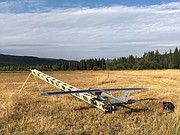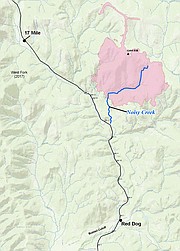Wildfires' growth slows, while containments tick up
Sterling Complex
No new growth was reported on the Pinkham Tower and Huckleberry fires that comprise the Sterling Complex — a Sunday morning incident report showed size and containment remaining at 1,405 acres and 79 percent, respectively.
“Firefighters [on Sunday] are mopping up deeper into the interior in the northcentral unburned area of the Pinkham Tower fire to extinguish remaining heat, in their efforts to ensure the fire is stable before calling it contained,” the incident report states. “Firefighters are still extinguishing small spot fires found while gridding in deep duff on the far northern flank of the fire.”
Firefighters were reported to be mopping up at the western and southern flanks and monitoring and patrolling at the northeast flank, “with repair work well underway.”
“A return to seasonal temperatures and breezy conditions in more open areas of the fire continues to dry fuels,” the report states. “No significant weather events are expected in the next few days, but drying of fuels may result in more heat showing itself in the form of creeping and smoldering in duff and in pockets of remaining heavy fuels and duff.”
Gold Hill
Sunday’s incident report showed the Gold Hill fire to have grown 170 acres since Thursday, to 3,682 acres, while containment increased from one percent to five percent.
Traffic delays were said to be expected daily on Pipe Creek Road between mile marker 12 and mile marker 17 from 9 a.m. to 5 p.m.
“The delays are necessary during fuels reduction operations as firefighters remove trees on the east side of the highway to create a fuel break,” the report states. “Creating a fuel break will help prevent fire from carrying across the road, thus minimizing the threat to private homes in the area.”
“Traffic will be allowed to go through at the top of each hour and delays will range from 30-60 minutes,” the report continues.
On Sunday, hotshot crews were expected to work the fire’s edge to “break up” heavy fuels by using chainsaws and constructing handlines.
“Operations to construct and improve indirect and contingency lines are ongoing,” the report states. “Heavy equipment is being utilized on interior roads to the north and east of the fire to create fuel breaks.”
Pre-evacuation orders still stood for properties near mile markers 11 and 13.
Davis
The Davis fire grew little since Thursday, reaching 6,614 acres while containment increased from 20 percent to 25 percent, according to a Sunday incident report that puts roughly 37 percent of the fire in Canada.
Fire officials anticipated little fire growth and low to moderate fire behavior.
“Firefighting crews have been successful in completing direct line in the Jungle Creek drainage,” the report states. “Crews will work to improve and secure this line over the next several days.”
On Sunday, weather was forecast to “be the warmest and driest day of the week, which could lead to increased fire activity,” while Monday was expected to bring cooler temperatures and higher humidity, with thermal-driven winds in valleys and on ridgetops.
“A small but important change for the overall pattern over northwest Montana is possible late on Monday [and through Thursday],” the report states. “The flow aloft may become southwest for more clouds and some cooling. Also, the low level winds will be light out of the East with gusts to 20 mph on the ridges.”





